- Vrittis in Yoga
- The Five Vrittis
- Right Cognition (Pramana)
- Misconception (Viparyaya)
- Imagination (Vikalpa)
- Sleep (Nidra)
- Memory (Smriti)
- Vrittis in Hindu Philosophy
- Controlling Vrittis
- Conclusion
- FAQs

In the journey of self-discovery through yoga, we often encounter a profound concept that lies at the heart of our inner exploration: “Vrittis.”
Vrittis are the ripples on the surface of the still lake of our consciousness, the chattering of the mind that can obscure the clarity of self-realization. To delve into the depths of yoga is to navigate these fluctuations and gain mastery over them, ultimately leading to a profound understanding of oneself.
In this article, we will explore the essence of Vrittis in yoga. We will unravel the meaning of Vrittis, delve into the significance of the “Chitta Vritti,” and uncover the profound wisdom embedded in the five distinct Vrittis described by Patanjali.
What Are Vrittis in Yoga?
Vrittis, often described as the “fluctuations of the mind,” form a fundamental concept in the philosophy of yoga. These mental fluctuations are central to understanding the workings of the mind and the path toward self-realization as outlined in Patanjali’s Yoga Sutra.

Defining Vrittis: At its core, the term “Vrittis” refers to the whirlpool of thoughts, emotions, and mental activities that constantly occupy our consciousness. These fluctuations can be compared to the ripples on the surface of a serene lake, disrupting its tranquillity.
Chitta Vritti: To grasp the essence of Vrittis, we must delve into the Sanskrit term “Chitta Vritti.” While often translated as “mind chatter” or “mental waves,” Chitta Vritti encompasses much more.
Chitta represents the entirety of consciousness in a person, and Vrittis are the thought patterns that emerge from it. These thought impulses can be fickle, chaotic, and disruptive, preventing us from experiencing our true nature.
The Quest for Self-Realization: Patanjali, the ancient sage and author of the Yoga Sutra, recognized that true self-realization could only be attained when the Chitta is liberated from the burdens of these Vrittis. Every practice within the realm of yoga, whether it’s the physical postures (Asana), breath control (Pranayama), meditation, or spiritual exploration, is ultimately aimed at this one profound goal – self-realization.
The Five Vrittis

Patanjali’s Yoga Sutra categorizes Vrittis into five types, each with its unique characteristics and effects on the mind.
- Right Cognition (Pramana): It refers to the ability to perceive information correctly based on our beliefs, experiences, and moral values.
- Misconception (Viparyaya): This vritti occurs when the mind incorrectly interprets sensory information.
- Imagination (Vikalpa): This vritti represents the mind’s ability to create mental images, fantasies, and daydreams.
- Sleep (Nidra): This vritti is more than just the absence of wakefulness. It’s an altered state of consciousness where the mind’s thought patterns are significantly reduced.
- Memory (Smriti): Smriti, or “memory,” involves the recollection of past sensations or emotions, both conscious and unconscious.
Each of these five Vrittis plays a distinct role in shaping our perception, thoughts, and consciousness. By delving into their individual characteristics and effects, we gain a deeper understanding of how they contribute to the tapestry of our mental landscape. Join us as we explore each Vritti in detail and uncover their significance in the practice of yoga.
1. Right Cognition (Pramana)
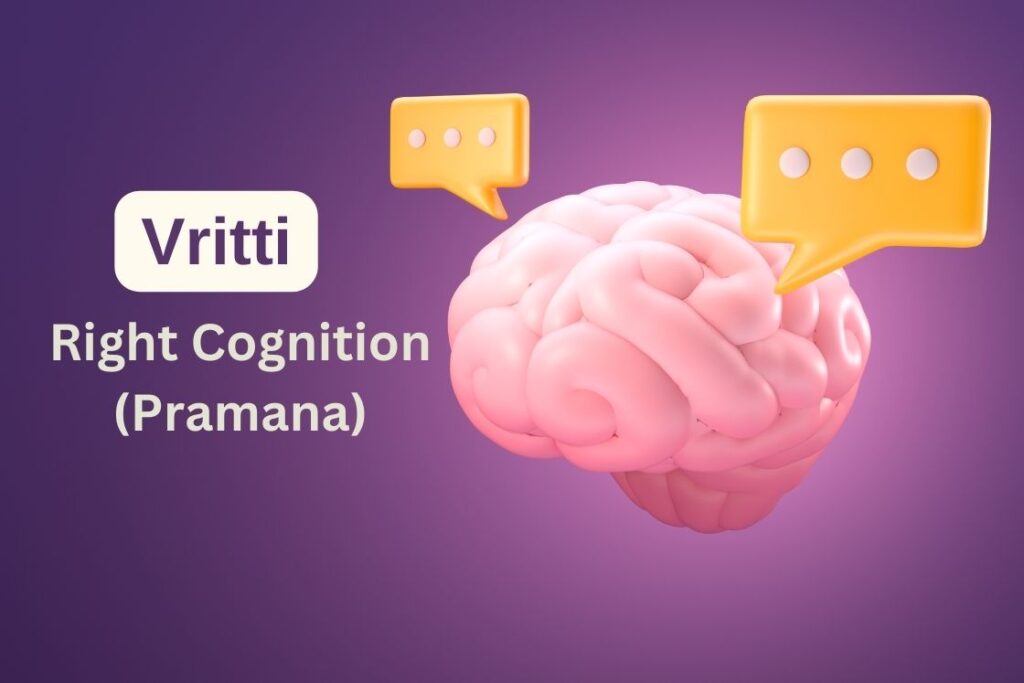
In the vast realm of mental fluctuations known as Vrittis, “Pramana” stands as the pillar of right cognition. This Vritti revolves around our ability to perceive information accurately, making it an indispensable aspect of our cognitive faculties.
Pramana essentially represents the mind’s quest for truth and knowledge based on belief, experience, and moral values.
The Six Types of Pramana Vrittis
Within the realm of Pramana, the mind employs a diverse set of tools to determine the validity of information. These six types of Pramana Vrittis are essential to our understanding of the world:
- Direct Experience (Pratyaksha): This is the most straightforward form of Pramana, relying on sensory perception. What we see, hear, taste, touch, and smell directly informs our understanding of reality.
- Inference (Anumana): Inference involves drawing conclusions based on observations. For example, if we see smoke, we infer the presence of fire.
- Comparison (Upamana): Upamana Pramana relies on comparison. When we relate something new to something familiar, we gain insights. For instance, a new fruit is described as “apple-like.”
- Postulation (Arthapatti): This form of Pramana helps us understand scenarios where direct evidence is lacking. For example, if a person never eats during the day but remains healthy, we postulate that they eat at night.
- Non-apprehension (Anupalabdhi): Anupalabdhi is the perception of the absence of something. It’s the recognition that something we expected to see or experience is not present.
- Verbal Testimony (Sabda): This involves gaining knowledge from credible sources, such as teachers, books, or experts. It’s an important Pramana as it enables us to access knowledge beyond our direct experiences.
Balancing Belief and Reality
While Pramana Vritti empowers us to acquire knowledge, it’s crucial to recognize that what we perceive as true may not hold the same truth for someone else. Belief systems, past experiences, and individual perspectives influence our understanding of reality. As seekers of self-realization, the recognition of these individual differences becomes vital.
In our journey to understand Pramana and its role in Vrittis, we navigate the path of discernment and wisdom. The ability to differentiate between personal belief and objective reality is a stepping stone toward clarity and self-realization.
2. Misconception (Viparyaya)
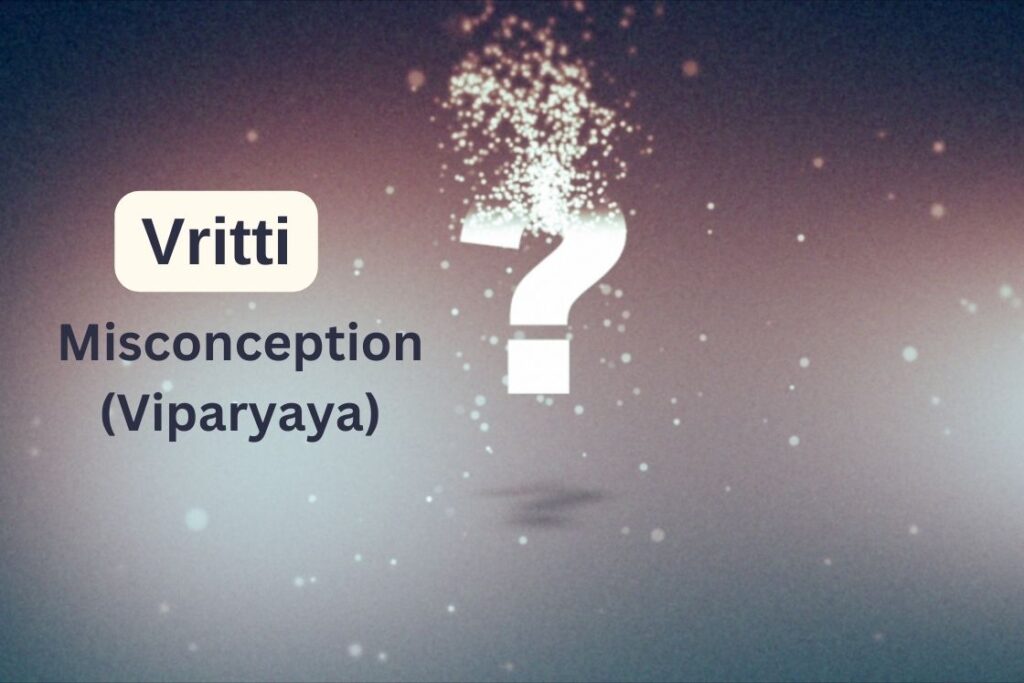
Viparyaya, often referred to as “misconception,” represents one of the five Vrittis that shape our mental landscape. This Vritti occurs when the mind incorrectly interprets sensory information, leading to a distortion of reality.
In the intricate tapestry of the mind’s fluctuations, Viparyaya can be likened to a mirage, where what we perceive may not align with the truth.
The Mirage Effect

To illustrate Viparyaya, consider the classic example of a mirage in the desert. From a distance, one might see what appears to be a shimmering pool of water on the arid horizon. The senses signal the presence of water, and the mind interprets it as a real body of water. However, upon closer examination, it becomes evident that there is no water, and the mirage dissipates.
This mirage effect encapsulates the essence of Viparyaya vritti. It highlights how our sensory perceptions can deceive us, leading to a false understanding of reality. It serves as a reminder that our senses, while powerful, are not infallible. The mind’s tendency to misinterpret sensory input can create illusions that obstruct our path to self-realization.
The Quest for Clarity
In the pursuit of self-realization through yoga, clarity and accurate perception are paramount. Recognizing the presence of Viparyaya within our mental landscape is the first step toward dispelling the fog of misconception. By acknowledging that our senses can sometimes lead us astray, we open the door to a more profound understanding of the true nature of reality.
3. Imagination (Vikalpa)
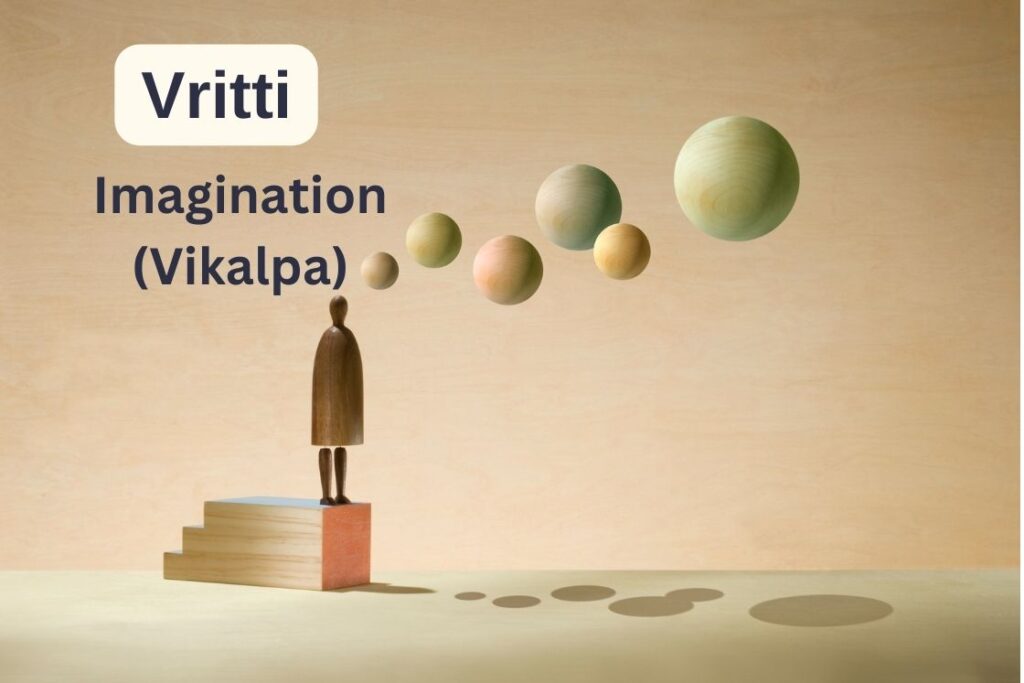
Vikalpa, often associated with imagination, is a fascinating Vritti that explores the creative depths of the mind. This mental fluctuation allows us to conjure mental images, fantasies, and daydreams. While imagination can be a wellspring of inspiration and innovation, it also has the potential to lead the mind astray if left unchecked.
Controlled Imagination (Kalpana)
One facet of Vikalpa worth exploring is controlled imagination, known as “Kalpana.” This form of imagination serves as a valuable tool for setting and achieving goals, problem-solving, and nurturing creativity. Controlled imagination allows us to envision possibilities, plan for the future, and bring our dreams to life.
Imagine an artist who envisions a masterpiece before putting a brush on canvas or an architect who mentally constructs a building before it stands in reality. These are examples of controlled imagination at work, harnessing the mind’s creative power for constructive purposes.
Uncontrolled Imagination (Vikalpa)
Conversely, uncontrolled imagination (Vikalpa) can be likened to a wandering mind lost in fantasy. It often leads to daydreaming, doubt, and indecision. While brief moments of wandering imagination can be harmless, unchecked Vikalpa Vritti can become a source of distraction and mental turmoil.
Think of a moment when you found yourself lost in an elaborate daydream, detached from the present reality. This is a manifestation of uncontrolled imagination. It diverts the mind from its intended focus and may hinder productivity and self-realization.
The Role of Yoga
In the practice of yoga, particularly in meditation and concentration exercises, we learn to harness and control the imaginative Vritti. By developing the ability to direct our imagination purposefully, we gain mastery over Vikalpa. This control allows us to channel creative energy and use it as a powerful force for self-realization.
Controlled imagination, in conjunction with focused meditation, can lead to profound insights and heightened awareness. It empowers us to visualize our goals, cultivate positive thoughts, and pave the way for transformation. Through disciplined practice, we discover that the mind, under our guidance, can be a wellspring of inspiration and self-discovery.
4. Sleep (Nidra)

Nidra, the Vritti of sleep, introduces us to an altered state of consciousness that is both mysterious and profound. In the landscape of mental fluctuations, Nidra represents a unique state where the mind’s thought patterns are significantly reduced. It’s a state where we experience rest and restoration, but it’s not merely the absence of wakefulness.
Nidra is akin to the moments just before falling asleep or those right upon waking. It’s a state where the mind’s usual chatter subsides, and we find ourselves in a realm where thoughts are minimal, if not absent. It’s a transient state that holds great potential for self-discovery and transformation.
The Importance of Quality Sleep
Quality sleep is essential for our overall well-being, both physically and mentally. Nidra not only allows the body to rejuvenate but also offers the mind a reprieve from the incessant thought waves of the waking state. It’s during these moments of rest that we find a sense of inner peace and balance.
Patanjali recognized the significance of experiencing peace of mind during deep sleep. In Yoga Sutra (1.38), he emphasizes the value of studying dreams and deep sleep states as a means to stabilize the mind. This implies that sleep, when approached mindfully, can contribute to our inner journey.
Yoga Nidra Practice
Within the realm of yoga, there exists a powerful practice known as “Yoga Nidra.” This ancient meditation practice allows individuals to consciously experience the activity of deep sleep while remaining awake and aware. Yoga Nidra guides practitioners through a state of deep relaxation, where they become observers of their thoughts and sensations.
Yoga Nidra provides a unique opportunity to explore the depths of consciousness while retaining a sense of mindfulness. It allows us to access the tranquil state of Nidra intentionally, rather than experiencing it solely as an unconscious part of our daily cycle.
5. Memory (Smriti)
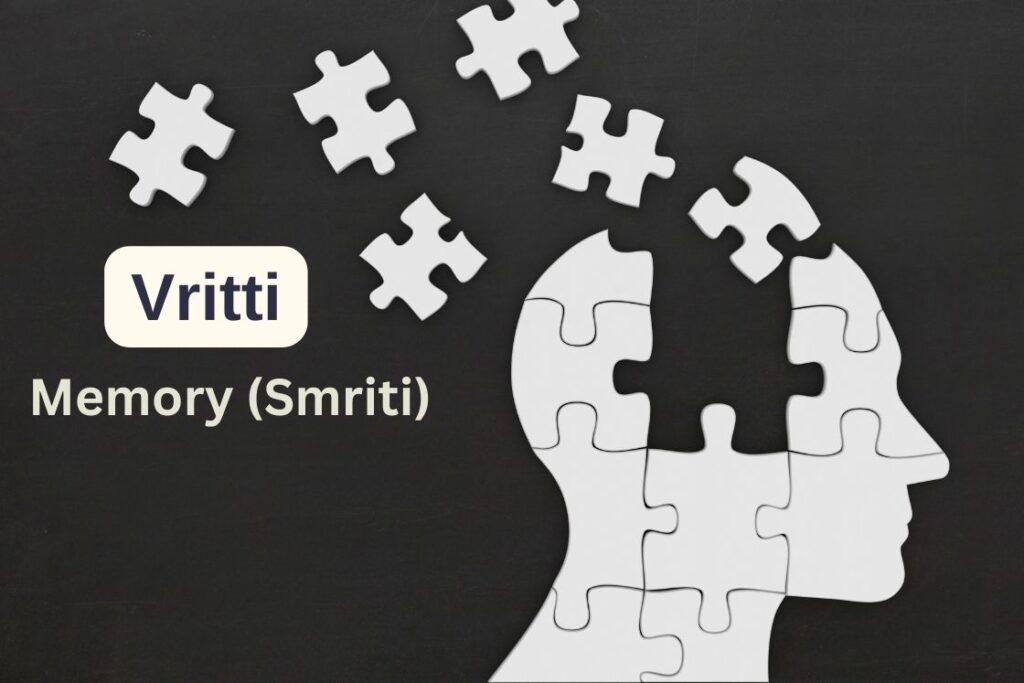
Smriti, often referred to as “memory,” is a Vritti that takes us on a journey through the corridors of our past. It involves the recollection of lasting impressions, both conscious and unconscious, that have been imprinted on the canvas of our mind by past sensations and emotions.
Think of Smriti as the mental archive that stores our life’s experiences, both significant and mundane. It encompasses memories of joy, sorrow, love, and countless other emotions, each with its unique vibrancy and texture. These memories shape our perception of the world and influence our responses to present situations.
Influence on Present Experiences
Smriti plays a crucial role in shaping our present moment. It affects our mood, decisions, and interactions with the world. When we encounter a situation, Smriti acts as a lens through which we view it. The memories we recall can either elevate our spirits or cast a shadow on our experiences.
For example, a positive memory of a past achievement can boost our confidence, while a negative memory may trigger anxiety or self-doubt. Smriti’s influence on our current state of mind is profound, and it can either facilitate our journey toward self-realization or hinder it.
Minimizing Past Influences
The practice of yoga, particularly meditation and one-pointed concentration, aims to minimize the impact of past experiences stored in Smriti. By cultivating mindfulness and residing in the present moment, we can learn to detach from the emotional charge of memories.
Vrittis in Hindu Philosophy
While the concept of Vrittis is prominently discussed in the context of Patanjali’s Yoga Sutras, it’s important to recognize that these mental fluctuations also hold significance within Hindu philosophy.
In Hindu philosophy, Vritti is often described based on the foundation of Samskara. Samskara represents the result of our past karma, the actions and deeds that accumulate over lifetimes. These accumulated impressions give direction to our emotions, behaviors, and responses to various life situations.
Vrittis, in this context, can be seen as the cyclical patterns of thought and behavior that arise from Samskara. They are like ripples that keep us bound to certain objects or attachments in the external world, thus creating disturbances in realizing higher consciousness.
These mental fluctuations, driven by past actions and impressions, can either propel us deeper into the cycle of birth and death (samsara) or serve as a means to transcend it. It’s the latter purpose that aligns Vrittis with the spiritual pursuits of self-realization and liberation (moksha).
Controlling Vrittis through Yoga

In the previous sections, we delved into the intricacies of Vrittis, those ever-changing mental fluctuations that influence our perceptions, emotions, and behaviors. Now, let’s explore how the practice of yoga serves as a powerful tool for controlling and mastering these Vrittis, ultimately guiding us towards self-realization and inner peace.
1. Awareness and Self-Observation
The journey towards controlling Vrittis begins with self-awareness. Yoga encourages us to become observers of our own minds. Through techniques like mindfulness meditation, we learn to watch the ebb and flow of thoughts without getting entangled in them. This awareness is the first step in gaining mastery over Vrittis.
2. Asana Practice
Physical postures or asanas are an integral part of yoga practice. Beyond their physical benefits, asanas also impact the mind. They help release physical tension and, in turn, reduce mental agitation. The practice of asanas prepares the body and mind for meditation, where the real work of Vritti control often takes place.
3. Pranayama for Mind Control
Pranayama, or the practice of controlling the breath, has a direct influence on the mind. By regulating the breath, we can calm the mind and reduce the fluctuations of Vrittis. Pranayama techniques like Nadi Shodhana (alternate nostril breathing) and Ujjayi (oceanic breath) are particularly effective in achieving mental clarity.
4. Concentration and Meditation:
Concentration and meditation are potent tools for mastering Vrittis. Dharana (concentration) involves focusing the mind on a single point, such as a mantra or the breath. This practice enhances mental discipline and gradually reduces the influence of Vrittis.
Meditation, or Dhyana, takes this process a step further. It involves sustained focus and the gradual quieting of the mind. In deep meditation, the Vrittis subside, allowing us to experience moments of profound stillness and self-realization.
5. Yoga Nidra
As discussed earlier, Yoga Nidra is a specialized practice that allows us to experience deep relaxation while maintaining awareness. It’s a powerful method for exploring the subtle realms of consciousness and minimizing the impact of Vrittis during the state of Nidra.
6. Cultivating a Yogic Lifestyle
Yoga isn’t limited to what happens on the mat or during formal meditation sessions. It’s a holistic way of life that extends into our daily activities. By practising the principles of yoga, including non-attachment (Vairagya) and self-discipline (Tapas), we gradually loosen the grip of Vrittis on our lives.
7. Seek Guidance and Study
Yoga is a vast and profound science. Seek guidance from experienced teachers and immerse yourself in the study of yogic philosophy. Understanding the deeper concepts of yoga and the nature of the mind can provide valuable insights into Vrittis and their control.
8. Persistence and Patience
Controlling Vrittis is not an overnight achievement. It’s a lifelong journey that requires persistence and patience. Be gentle with yourself, and remember that setbacks are a natural part of the process. Each step you take brings you closer to mastering your mental fluctuations.
Conclusion: Mastering Vrittis for Inner Peace and Self-Realization
Vrittis are the ever-changing mental fluctuations, encompassing thoughts, emotions, and patterns of the mind, at the heart of yoga philosophy. These Vrittis are mainly of five types Right Cognition (Pramana), Misconception (Viparyaya), Imagination (Vikalpa), Sleep (Nidra), and Memory (Smriti), each with its unique influence on our daily lives and spiritual journey.
Controlling Vrittis is central to the practice of yoga, and it begins with self-awareness and mindfulness. By engaging in yogic techniques such as meditation, asanas, pranayama, and concentration, individuals can gain mastery over these mental fluctuations. Through a consistent yogic lifestyle and unwavering dedication, one embarks on a transformative journey toward self-realization, unlocking the profound inner peace that lies beyond the realm of Vrittis. The path may be challenging, but with persistence and self-compassion, it leads to the realization that the fluctuations of the mind are not obstacles but stepping stones toward reaching our highest potential.
FAQs on Vrittis in Yoga
Vrittis are the fluctuations of the mind, encompassing thoughts, emotions, and mental patterns. They are crucial in yoga because they can either hinder or facilitate our journey towards self-realization.
Start by practising mindfulness meditation. Sit quietly, observe your thoughts without judgment, and note any recurring patterns or emotions. This self-awareness is the first step in recognizing and understanding your Vrittis.
While complete elimination of Vrittis may be challenging, the goal in yoga is to gain control over them. With practice, you can significantly reduce their influence and experience moments of mental stillness and clarity.
The challenges in controlling Vrittis vary from person to person. Some may find the Vritti of Imagination (Vikalpa) particularly challenging, while others may struggle with Misconception (Viparyaya). It depends on one’s unique mental tendencies and conditioning.
Yes, Vrittis can have positive aspects. Controlled imagination (Kalpana) can foster creativity, and right cognition (Pramana) helps us discern truth. However, the key lies in managing them effectively and not letting them dominate our consciousness.

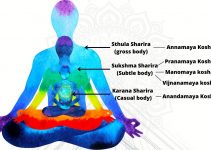



very authentic information sir thank u
Thank you Ashish for the wonderful information on yoga sutras. these articles are very helpful in understanding the hidden meaning of these sutras.
very informative. thank you.
Thank you. It was helpful.
I am glad you found it helpful. Keep in touch for more interesting articles:)
Such a useful.. Info@
If possible try to Giv a article about types of Japas in mantrayoga
Hi Pratibha, we’ll try our best to write on Japas in mantrayoga as soon as possible. As soon as we do it, will notify you by email. Till then keep reading our blog posts, Thank you. Namaste 🙂
Really amazed through your articles.
Could you please suggest me the right way to attain this knowledge along with practice of yoga. Pls guide.
Hi Kamal, thanks for the appreciation. I am glad you found my writings helpful & want to learn more yoga knowledge.
If you are seeking to attain knowledge about Vrittis, the whole yogic literature stood only upon this concept. The right way to attain knowledge about it is to build the very base of yoga i.e. Yama & Niyama. Once you mastered these two, it means you have gained 80% of yogic practice. 10 principles described in Yama & Niyama works indirectly on controlling thought patterns of mind (Vrittis) as well.
Hope it will help you. Namaste 🙂